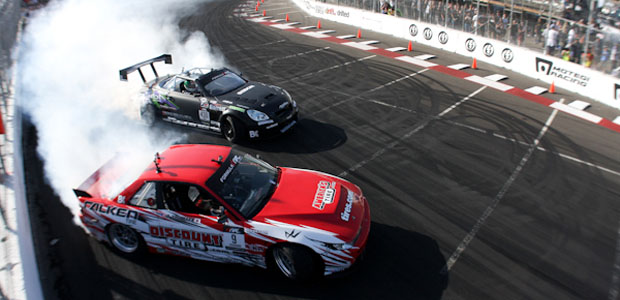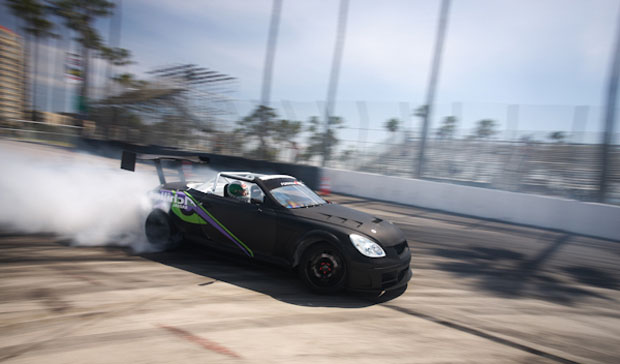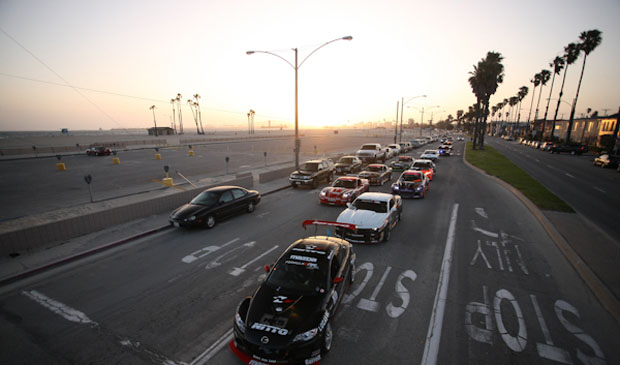
Competition heats up at the Streets of Long Beach competition held the week before the Toyota Grand Prix each year. All photos by Larry Chen courtesy of Formula D.
Ten years ago, Jim Liaw and Ryan Sage were Irvine-based automotive marketing specialists approached to put on an unheard-of event for a new client. The client operated an organized series for a little-known Japanese-invented motorsport called drifting and he wanted to host a Southern California exhibition where local street racers could come and compete alongside experienced Japanese drivers.
The only problem was that a judged competition based around forcing a speeding stock-body car into an intentional, controlled fishtail was still a new idea in the States, only known to a few underground groups and drag racing daredevils.
But after more than a year of explaining the concept to confused car enthusiasts— and prepping a few American drivers for the international competition— the exhibition brought recordbreaking attendance to the Irwindale Speedway and told the marketing duo that drifting could become something bigger.
“We walked away from it with a huge response from sponsors, media, drivers and spectators,” Liaw says from his current office in Downtown Long Beach. “It was a sign—people will like this. And we wanted to respectfully continue that momentum.”

Six months later, Liaw and Sage’s Formula DRIFT had the first event of its inaugural season, making it the first professional drifting series outside of Japan and solidifying their role in establishing America’s pro drifting roots. Within two years, they folded their marketing company to run the series full time and soon, the company moved to Long Beach, where it holds an annual competition on city streets the week before Grand Prix.
The sport quickly gained momentum among young fans who took to the high-intensity, short-format competition in which drivers go against each other in a head-to-head battle and are judged based on how well they can control their tandem, drifting cars around a short, curvy track.
Excitement comes from watching professional drifters push their vehicles to the literal edge of what physics will allow them to do, entering sideways slides at more than 80 miles per hour and getting extreme proximity—the industry term for how close cars are to one another.
Adding to Formula DRIFT’s appeal is the fact that the sport is a blend of traditional motorsports and extreme or action sports. Unlike NASCAR, Indy- Car racing and Formula One, drifting competitions are subjective in nature. But unlike other judged sports—such as skateboarding, motorcross and BMX— drifting is done in a car.
“Drifting is the only motorsport where getting from point A to point B is irrelevant to the final equation of whether or not you can be successful,” says Sage. “The point of drifting is not racing. The point is aesthetics. The point is style. The point is winning in a head to head battle, not 20 drivers hitting the track at the same time.”
Dealing with drifting’s subjectivity, however, is the most challenging part of the sport, Liaw and Sage say. But by introducing specific rules and stringent judging criteria into the competitions, Formula DRIFT was able to set the American incarnation of the sport apart from its Japanese originators and take it to the next level.
So instead of merely being fun entertainment content for publishing companies (as was the case with the original Japanese series), Formula DRIFT repurposed the onetime street trend for a more rigid international sporting market where teams are miniature businesses in themselves and drivers can earn massive sponsorship deals.

“It all comes from the same roots and the way the competition is formatted is conceptually the same,” Liaw says. “But in the early part of development, we took on a more sporting role…Some of the drivers thought we went overboard and made everything super serious, but I think it showed we were focused and it’s allowed us to be where we are today.”
Growth seems inevitable for the series, which since its first season in 2004, has increased the number or Pro Championship events from four to seven. In September, Formula DRIFT’s television program—which pares down more than 16 hours of competition into a slick 30-minute magazine-style program— aired for the first time on NBC Sports. And on October 12 and 13, the series held the final competition of its 2012 season at Irwindale Speedway—with more than 50 drivers from 15 countries registering for the 32 qualifying spots.
The most recent event in Irwindale marks almost nine years to the month since Liaw and Sage put on their first drifting event at the venue. And with more and more millenials discovering the sport each year, Formula DRIFT’s exponential success does not show any signs of slowing.
“It fits perfectly into the internet demographic,” says Sage. “If you’re an Instagrammer or you’re on Twitter or you have ADHD and need to always be doing something, then drifting is perfect because you’ll never have to wait until the 7th inning for someone to hit a homerun. It‘s like a boxing match is happening every few minutes except there are only two minutes of punching and then you pick a winner.”
—This story originally appeared in print in the October 2012 edition of the Post. Pick one up at a location near you!

